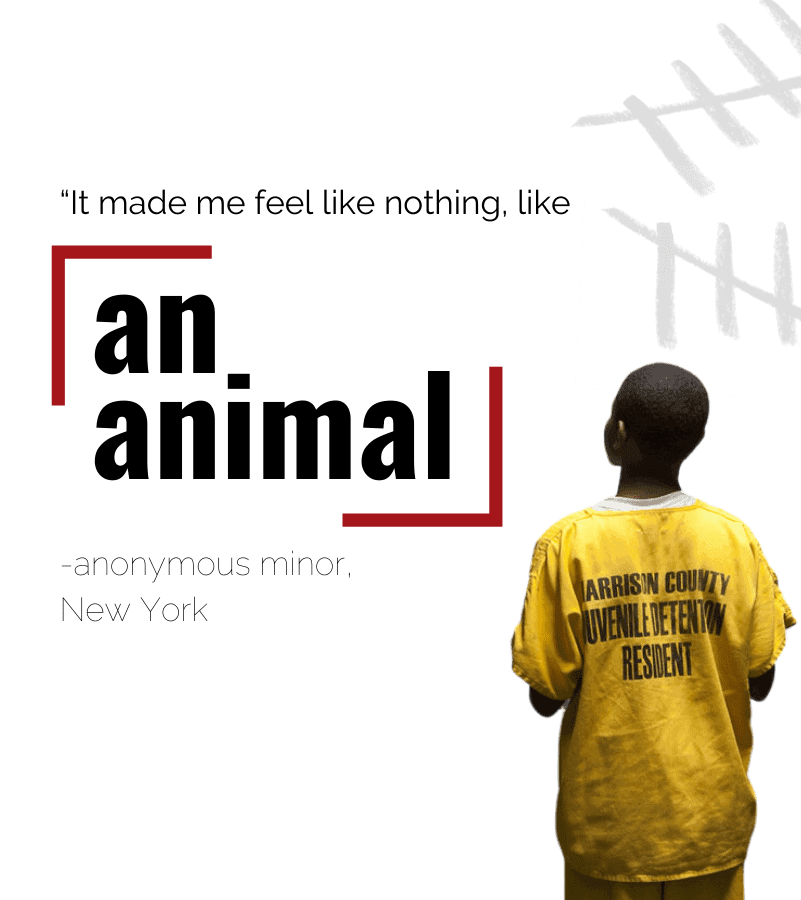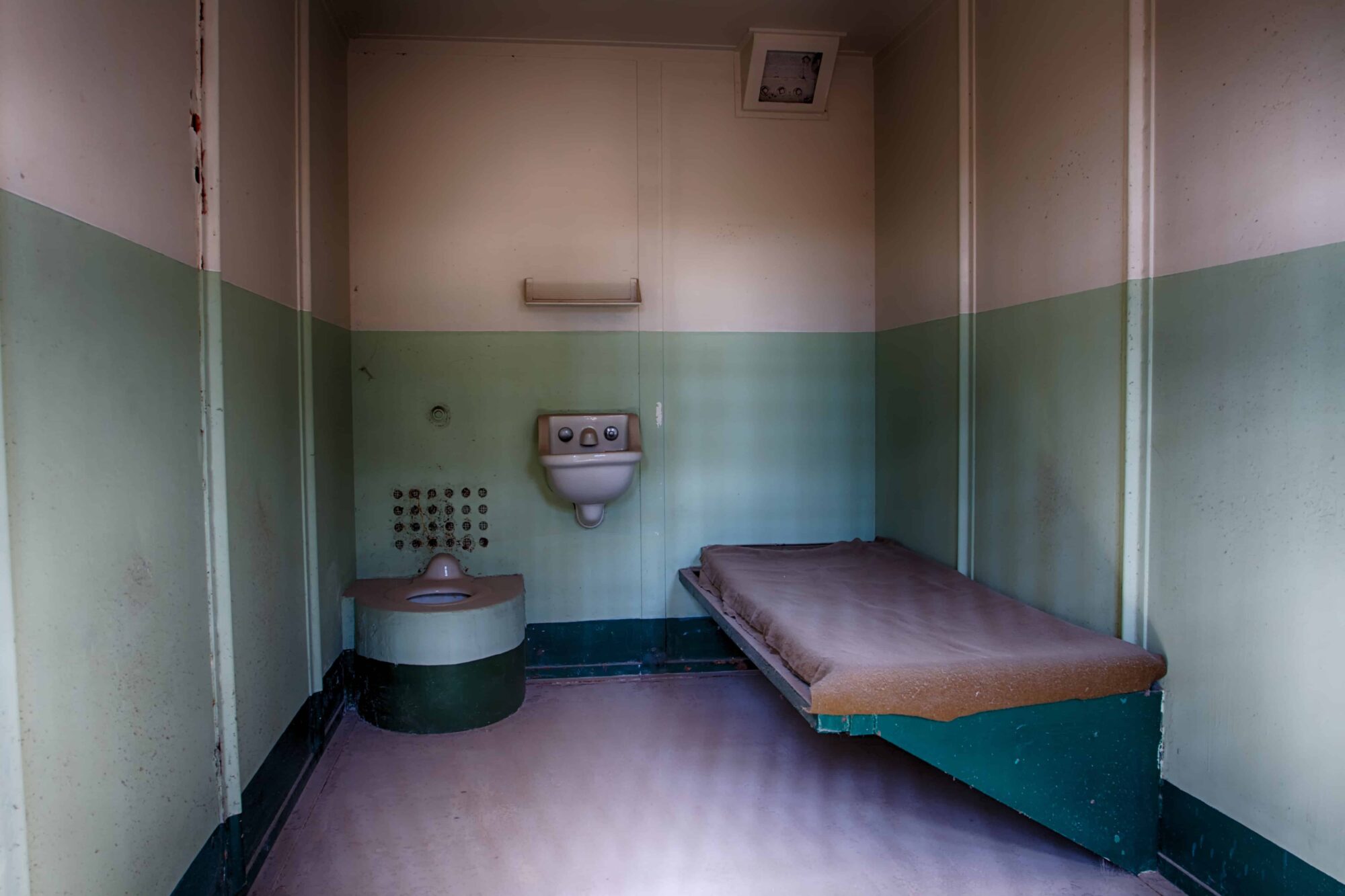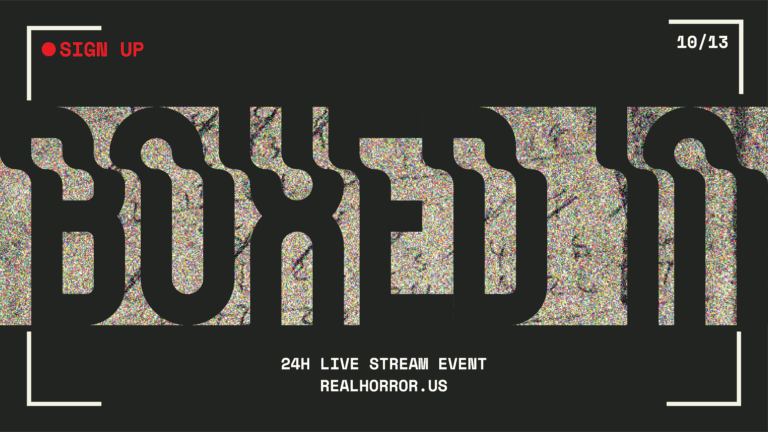EXPERIENCE
What is solitary like?
No one should ever have to experience solitary confinement first-hand. But understanding what it’s like can help to prove why it’s so important to abolish it.
According to the most current federal data, more than 30% of youth in facilities report being in solitary confinement. Nearly 50% of training schools and detention centers admit to putting kids in solitary confinement. Girls, LGBTQ youth, youth with disabilities and mental health disorders, and youth of color are likely to be most affected by solitary confinement.

INSIDE THE BOX
LIFE IN SOLITARY CONFINEMENT
Survivors of solitary confinement and people currently being held in isolation shared some of the more distressing facts about living in solitary confinement. Click on the buttons below to gain an understanding of some of the most common practices associated with living under these torturous conditions.[24]

MORE VOICES FROM SOLITARY
Solitary Watch’s Voices from Solitary series features real-life accounts of life in isolation, written by people in solitary confinement. These accounts illuminate not only the effects of solitary, but the human beings who endure these torturous conditions.
-
Voices from Solitary: The Crisis at Brooklyn’s “Dangerous, Barbaric” Federal Jail
Sean Chaney is a formerly incarcerated artist who served a total of 18 years in various federal prisons before returning home in January 2025. Chaney spent significant time in solitary confinement, including a total of 12 years isolated at Federal […]
-
Voices from Solitary: Across the Plexiglass
Dwayne “Bim” Staats is currently incarcerated in the Delaware Department of Corrections. Out of his 21 years of incarceration, Staats has spent nearly 17 years in solitary confinement in prisons across Pennsylvania and Delaware. Staats […]
-
Voices from Solitary: Crawling Out of the Darkness, Part 2
Having survived over two decades in solitary confinement, Jacob Barrett is currently incarcerated at Oregon State Correctional Institution for crimes committed when he first entered prison at nineteen years old. In addition to his work as an ADA […]
-
Voices from Solitary: Crawling Out of the Darkness, Part 1
First incarcerated at the age of 19, Jacob Barrett has spent the last three decades behind bars. Spanning five “supermax” units and 18 jails and prisons in five states, his prison time has included 21.5 years in solitary confinement. Upon his […]
-
Voices from Solitary: The Crisis at Brooklyn’s “Dangerous, Barbaric” Federal Jail
Sean Chaney is a formerly incarcerated artist who served a total of 18 years in various federal prisons before returning home in January 2025. Chaney spent significant time in solitary confinement, including a total of 12 years isolated at Federal […]
-
Voices from Solitary: Across the Plexiglass
Dwayne “Bim” Staats is currently incarcerated in the Delaware Department of Corrections. Out of his 21 years of incarceration, Staats has spent nearly 17 years in solitary confinement in prisons across Pennsylvania and Delaware. Staats […]
-
Voices from Solitary: Crawling Out of the Darkness, Part 2
Having survived over two decades in solitary confinement, Jacob Barrett is currently incarcerated at Oregon State Correctional Institution for crimes committed when he first entered prison at nineteen years old. In addition to his work as an ADA […]
-
Voices from Solitary: Crawling Out of the Darkness, Part 1
First incarcerated at the age of 19, Jacob Barrett has spent the last three decades behind bars. Spanning five “supermax” units and 18 jails and prisons in five states, his prison time has included 21.5 years in solitary confinement. Upon his […]
solitary: The psychological and physical effects
Most frequent questions and answers
Neuroscientists have found that long term isolation, in and of itself, is extremely damaging to the brain. Social and sensory deprivation can lead to damage to the brain’s hippocampus, resulting in loss of memory, cognitive impairments, and depression, which in turn results in further brain cell death. The sensory deprivation and natural light deprivation can also cause psychosis and other harm. People who are placed in solitary confinement, for even very short periods of time, are subject to significant mental anguish and deterioration. Common symptoms include panic attacks, paranoia, social withdrawal, sensitivities to sound, and other external stimuli. [25]
Increased risk of self harm, from cutting to amputation to suicide, have long been associated with solitary confinement. While in isolation, adverse psychological effects of sensory deprivation can lead to psychosis, which can lead to self-harm. These effects remain with people long after they are released from solitary. Research suggests that once released, solitary survivors are 78% more likely to commit suicide within a year of their release than those not exposed to isolation. [26]
The experience of solitary confinement is especially damaging to youth, 25 and under, because their brains are still developing. The psychological stress of being in solitary confinement can inhibit parts of the brain like the pre-frontal cortex from growing and cause irreversible harm. Restricted from social interaction and educational opportunities, youth exposed to solitary have a difficult time adjusting to life after release, and are more likely to harm themselves or commit suicide than those not exposed. One extensive study found that 60% of all incarcerated youth suicides are committed by those who either are or have been in solitary confinement. [27]
Solitary confinement is linked to decrease in physical and mental health. In addition to psychological effects, solitary is associated with heart disease as well as increased risk of death even after release from prison, including by suicide and overdose. One study reported that it’s associated with a 26% increase in premature death due to increased cortisol levels, higher blood pressure, and inflammation. [28]
Solitary confinement creates barriers to physical and mental healthcare. In many cases, clinical assessments are performed through bars or solid metal doors, which greatly impedes clinicians’ ability to physically assess and even communicate with patients. Patients are often restricted from inpatient psychiatric treatment. Moreover, life-threatening medical emergencies easily go undetected due to isolation, sometimes resulting in serious harm or even death.[29]
Solitary confinement can cause long-term mental and physical harm, including after people are released from prison and jail and including premature death. Also, as Dr. Craig Haney, an expert on solitary confinement, pointed out in Congressional Testimony, people placed in long-term isolation can develop long lasting social pathologies as a result of social deprivation. People can lose their sense of self, become unable to connect to reality, or have difficulty controlling their behavior. People can develop overwhelming anxiety about social interaction. In most cases, people released from solitary are not provided with transitional services to help them adjust after isolation, further exacerbating the problem. [30]
Solitary: A Virtual Experience
What’s it like to spend almost every hour of the day in a cell measuring 6×9 feet for days, weeks, months or even years? Johnny Perez and Dolores Canales, members of the Unlock the Box Steering Committee, collaborated with The Guardian, Solitary Watch, and other survivors of solitary to create “6×9: A Virtual Reality Experience,” which places you inside a U.S. solitary confinement cell as voices describe what it’s like to live in complete isolation. A mobile app allows you to fully experience ”6×9” on your own, with or without a VR viewer. If you don’t have a smartphone, scroll down to watch the 360° video.
Download the app for the full virtual experience:
The youth experience
Our colleagues at the Campaign for the Fair Sentencing of Youth collaborated with Johnny Perez, a member of our Steering Committee, and Laura Nicks, a member of our state campaign partner, DecARcerate Arkansas, to create this virtual experience illustrating what it’s like to be a young person enduring the torture of solitary confinement.


